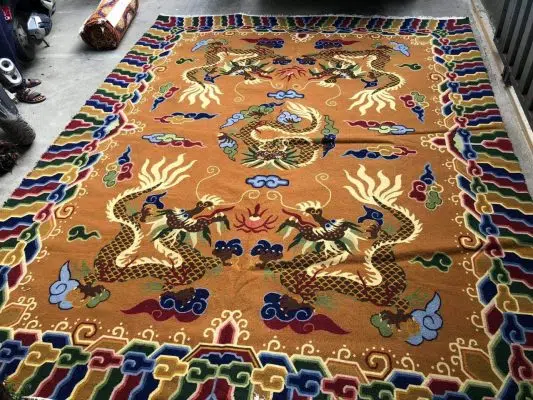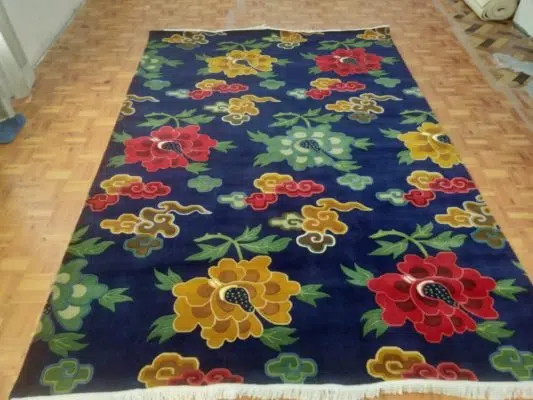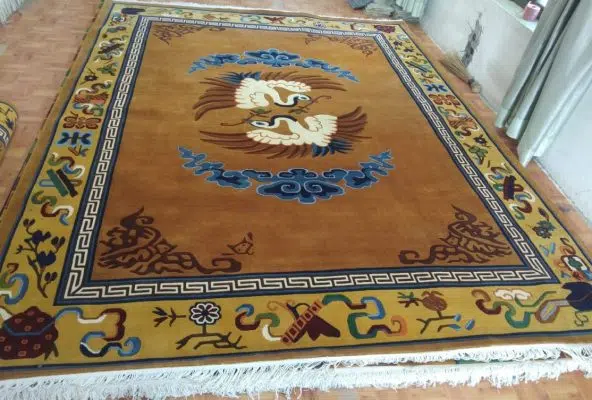Blog
Bedroom Tibetan Carpets
![]()
Table of Contents
Bedroom Tibetan Carpets: Tradition, Beauty, and Comfort
Introduction to Bedroom Tibetan Carpets
Bedroom Tibetan Carpets: Tibetan carpets have long been revered for their intricate designs, exceptional craftsmanship, and cultural significance. Originating from the Tibetan Plateau, these carpets were traditionally woven for domestic use, religious purposes, and as offerings to monasteries. Today, Tibetan carpets are appreciated worldwide for their beauty and durability, making them an excellent choice for various spaces, including bedrooms. This in-depth guide explores the history, craftsmanship, design, and integration of Tibetan carpets in bedrooms, offering practical advice on choosing, caring for, and appreciating these exquisite floor coverings.
Historical and Cultural Significance of Tibetan Carpets
Origins and Evolution
The art of Tibetan carpet weaving can be traced back to the 7th century, during the reign of Songtsen Gampo, the 33rd king of Tibet. Initially, carpets were woven primarily for practical purposes, such as floor coverings, wall hangings, and saddle blankets. They were also used in religious contexts, often donated to monasteries or used during ceremonies. Over the centuries, Tibetan carpet weaving evolved, incorporating influences from neighboring cultures such as China, India, and Persia, yet maintaining distinct characteristics.
The introduction of new materials and techniques during the 19th and 20th centuries brought significant changes to Tibetan carpet weaving. While traditional patterns and motifs remained popular, weavers began experimenting with new designs, colors, and methods. Despite these changes, the essence of Tibetan carpet weaving – its emphasis on quality, symbolism, and craftsmanship – has remained intact.

The Craftsmanship Behind Tibetan Carpets
Wool Sourcing and Preparation
One of the distinguishing features of Tibetan carpets is the quality of the wool used. The wool comes from highland sheep that graze on the Tibetan Plateau. These sheep are raised in natural conditions, free from synthetic hormones or antibiotics, resulting in wool that is both high-quality and eco-friendly. The wool is prized for its long fibers, softness, and durability.
The preparation of wool for Tibetan carpets involves several meticulous steps:
- Shearing: The wool is carefully sheared from the sheep to ensure the animals are not harmed.
- Cleaning: The raw wool is washed to remove dirt, grease, and other impurities.
- Carding: The cleaned wool is carded to disentangle and align the fibers.
- Spinning: The wool is hand-spun into yarn, a process that preserves the integrity of the fibers and enhances the strength of the yarn.
Dyeing Process
The dyeing process of Tibetan carpets is an art in itself, requiring great skill and patience. Traditional Tibetan carpets are known for their vibrant and long-lasting colors, achieved through the use of natural dyes derived from plants, minerals, and other organic materials. Common dye sources include:
- Madder root: Produces rich reds and pinks.
- Indigo: Yields deep blues.
- Walnut husks: Create various shades of brown.
- Turmeric and saffron: Offer bright yellows and oranges.
The dyeing process involves boiling the wool in dye baths, often requiring multiple dips to achieve the desired intensity. The use of natural dyes not only adds to the authenticity of the carpets but also ensures that the colors age gracefully over time.
Weaving Techniques
The weaving process is where the true artistry of Tibetan carpets comes to life. Tibetan weavers use a vertical loom and the Tibetan knotting technique, which is distinct from other knotting methods like the Persian or Turkish knot. The Tibetan knot involves looping the yarn around a metal rod, creating a loop that is then cut to form individual knots. This method allows for intricate designs and contributes to the unique texture of Tibetan carpets.
The design is usually drawn on graph paper, serving as a blueprint for the weaver. Skilled artisans, often with years of experience, translate these designs into the carpet, knot by knot. The process is labor-intensive, with larger carpets taking several months to complete.
Design Elements of Tibetan Carpets
Symbolic Motifs and Patterns
Tibetan carpets are rich in symbolism, with many designs reflecting Buddhist iconography and Tibetan culture. Common motifs include:
- Dragons: Symbolizing power and protection.
- Lotus flowers: Representing purity and enlightenment.
- Clouds and waves: Denoting harmony and the cyclical nature of life.
- Geometric patterns: Often used as borders or central medallions, symbolizing stability and structure.
Each motif tells a story and carries specific meanings, adding depth and context to the carpet’s beauty.
Color Schemes
The color schemes of Tibetan carpets are as varied as their designs. Traditional carpets often feature bold and contrasting colors like deep reds, blues, and golds, which are both visually striking and meaningful. Modern interpretations might use a more subdued palette, incorporating neutral tones to blend seamlessly with contemporary interiors. Regardless of the color scheme, the use of natural dyes ensures that the colors remain vibrant and rich.
Also visit:-
Integrating Tibetan Carpets into Bedroom Decor
Aesthetic Appeal
Tibetan carpets bring a unique aesthetic appeal to bedrooms, blending traditional craftsmanship with modern design sensibilities. Their intricate patterns and rich colors can serve as a focal point, adding a touch of elegance and sophistication to the space. Whether placed under the bed, at the foot of the bed, or as a centerpiece in an open floor plan, Tibetan carpets enhance the overall decor with their timeless beauty.
Versatility in Design
One of the strengths of Tibetan carpets is their versatility. They complement a variety of interior styles, from classic and traditional to modern and eclectic. Here are a few ways to incorporate Tibetan carpets into different bedroom styles:
- Traditional: Pair a Tibetan carpet with antique furniture, ornate woodwork, and classic art pieces. The rich colors and intricate designs of the carpet will harmonize with traditional elements, creating a cohesive and elegant look.
- Modern: Use a Tibetan carpet with a more muted color palette to add texture and interest to a minimalist modern bedroom. The carpet’s patterns can break the monotony of clean lines and neutral tones, adding warmth and character.
- Bohemian: Embrace the eclectic and vibrant nature of Bohemian decor by layering a Tibetan carpet with other textured textiles, colorful cushions, and eclectic furnishings. The carpet’s bold patterns and colors will enhance the free-spirited and artistic vibe.

Practical Benefits
Aside from their aesthetic appeal, Tibetan carpets offer practical benefits for bedrooms:
- Comfort: The thick wool pile provides a soft and comfortable surface, making the bedroom cozier and more inviting.
- Insulation: Wool is an excellent insulator, helping to maintain a comfortable temperature in the bedroom throughout the year.
- Durability: The high-quality wool and expert craftsmanship ensure that Tibetan carpets are durable and can withstand heavy use, making them ideal for both adult and children’s bedrooms.
Choosing the Right Tibetan Carpet for Your Bedroom
Size and Placement
When choosing a Tibetan carpet for your bedroom, consider the size and placement to ensure it complements the space effectively. Here are some guidelines:
- Under the Bed: Choose a carpet that extends beyond the edges of the bed, creating a frame around the bed. A standard guideline is to leave about 24 inches of carpet visible around the bed.
- At the Foot of the Bed: A smaller carpet placed at the foot of the bed can add a decorative touch and provide warmth for your feet when you get out of bed.
- As a Centerpiece: In larger bedrooms, a Tibetan carpet can be used as a central feature, anchoring the room’s design. Ensure the carpet is proportional to the room size to maintain balance.
Color and Design
The color and design of the carpet should harmonize with your bedroom decor. Consider the following:
- Color Scheme: Choose colors that complement or contrast with your bedroom’s color palette. For a cohesive look, select a carpet with colors that match your bedding, curtains, or wall color. For a bold statement, choose a carpet with contrasting colors to add visual interest.
- Design Patterns: Select patterns that resonate with your personal style and the overall theme of your bedroom. Traditional motifs add a classic touch, while modern designs can enhance contemporary spaces.
Material and Quality
Ensure that the carpet is made from high-quality wool and natural dyes. Authentic Tibetan carpets are hand-woven, and the quality of the craftsmanship significantly impacts the carpet’s durability and aesthetic appeal. Look for carpets that come with certifications from organizations like GoodWeave, which ensure ethical production practices.
Caring for Your Tibetan Carpet
Regular Maintenance
Proper care and maintenance are essential to preserve the beauty and longevity of your Tibetan carpet. Here are some tips for regular maintenance:
- Vacuuming: Vacuum the carpet regularly to remove dirt and debris. Use a vacuum with a brush attachment to avoid damaging the fibers.
- Rotation: Rotate the carpet periodically to ensure even wear and prevent specific areas from becoming overly worn.
- Spot Cleaning: Address spills and stains immediately. Blot the spill with a clean cloth and use a mild detergent mixed with water to clean the affected area. Avoid using harsh chemicals.
Professional Cleaning
Despite regular maintenance, Tibetan carpets may require professional cleaning to remove deep-seated dirt and stains. It’s advisable to have your carpet professionally cleaned every 1-2 years. Professional cleaners have the expertise and equipment to clean the carpet thoroughly without damaging the fibers or colors.

Protecting from Sunlight and Moisture
Direct sunlight can cause the colors of the carpet to fade over time. To protect your carpet, place it in an area with limited direct sunlight or use window treatments to filter the sunlight. Additionally, avoid placing the carpet in areas prone to moisture, as prolonged exposure to moisture can damage the wool and promote mold growth.
The Market for Tibetan Carpets
Ethical Considerations
When purchasing a Tibetan carpet, it’s important to consider the ethical implications. Look for carpets that are certified by organizations like GoodWeave, which ensures that the carpets are made without child labor and adhere to fair labor practices. Supporting ethical production not only ensures high-quality craftsmanship but also contributes to the well-being of the artisans and their communities.
Investment Value
Tibetan carpets are not only beautiful home decor pieces but also valuable investments. High-quality, hand-woven Tibetan carpets can appreciate in value over time, especially if they are well-maintained and feature rare designs or exceptional craftsmanship. As with any investment, it’s important to research and purchase from reputable dealers or directly from artisans to ensure authenticity.
Customization Options
Many Tibetan carpet producers offer customization options, allowing you to create a carpet that perfectly fits your bedroom’s size, color scheme, and design preferences. Custom-made carpets provide an opportunity to own a unique piece that reflects your personal style while maintaining the traditional craftsmanship and quality.
Also visit:-
Appreciating the Artistry of Tibetan Carpets
Understanding the Symbolism
Tibetan carpets are rich in symbolism, often featuring motifs and patterns with deep cultural and religious meanings. Understanding the symbolism behind the designs can enhance your appreciation of the carpet’s artistry. For example, dragons symbolize power and protection, lotus flowers represent purity and enlightenment, and geometric patterns convey stability and structure.
The Weaving Process
Appreciating the time and skill involved in the weaving process can deepen your admiration for Tibetan carpets. Each carpet is a labor of love, taking months to complete. The weavers’ attention to detail and dedication to their craft are evident in the intricate designs and high-quality construction.
Supporting Artisan Communities
Purchasing a Tibetan carpet is not just about acquiring a beautiful piece of decor; it’s also about supporting the artisans who create these masterpieces. Many Tibetan weavers rely on their craft as a primary source of income. By choosing ethically produced carpets, you contribute to the preservation of traditional crafts and the economic well-being of artisan communities.
Conclusion: Bedroom Tibetan Carpets
Bedroom Tibetan carpets are more than just decorative pieces; they are embodiments of a rich cultural heritage and unparalleled craftsmanship. Their intricate designs, vibrant colors, and durable materials make them a perfect addition to any bedroom, offering both aesthetic appeal and practical benefits. By choosing a Tibetan carpet, you not only enhance your home’s decor but also support sustainable and ethical practices that preserve traditional crafts and empower local communities. Whether you’re drawn to the cultural significance, the exquisite artistry, or the luxurious comfort, a Tibetan carpet is a timeless investment that brings beauty and history into your home.
Summary of above content on Bedroom Tibetan Carpets:-
- Bedroom Tibetan carpets add an elegant touch and cultural richness to any bedroom decor.
- Crafted from high-quality wool, bedroom Tibetan carpets offer a soft and luxurious feel underfoot.
- The intricate designs of bedroom Tibetan carpets can serve as a focal point in your bedroom.
- Bedroom Tibetan carpets are known for their durability, making them a long-lasting investment.
- With natural dyes, bedroom Tibetan carpets feature vibrant colors that remain vivid over time.
- The hand-woven nature of bedroom Tibetan carpets ensures each piece is unique and meticulously crafted.
- Bedroom Tibetan carpets can enhance the aesthetic appeal of both traditional and modern bedroom designs.
- The natural insulation properties of bedroom Tibetan carpets help maintain a comfortable bedroom temperature.
- Placing bedroom Tibetan carpets under the bed or at its foot adds warmth and coziness to the space.
- The symbolic motifs in bedroom Tibetan carpets, like dragons and lotus flowers, bring cultural significance and meaning.
- Regular vacuuming and spot cleaning keep bedroom Tibetan carpets looking fresh and well-maintained.
- Customization options for bedroom Tibetan carpets allow you to match your bedroom’s specific size and color scheme.
- The versatility of bedroom Tibetan carpets makes them suitable for various bedroom styles, from minimalist to bohemian.
- Investing in bedroom Tibetan carpets supports ethical practices and preserves traditional craftsmanship.
- Using a rug pad under bedroom Tibetan carpets can prevent slipping and add extra cushioning for enhanced comfort.


